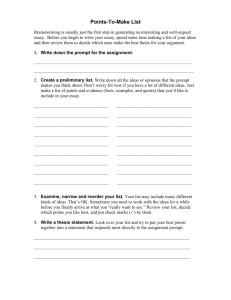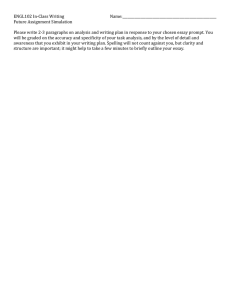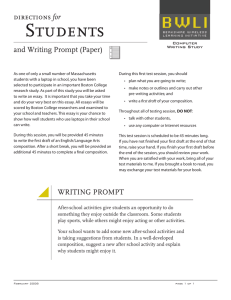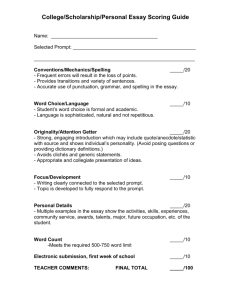What AP Readers Long to See…
advertisement
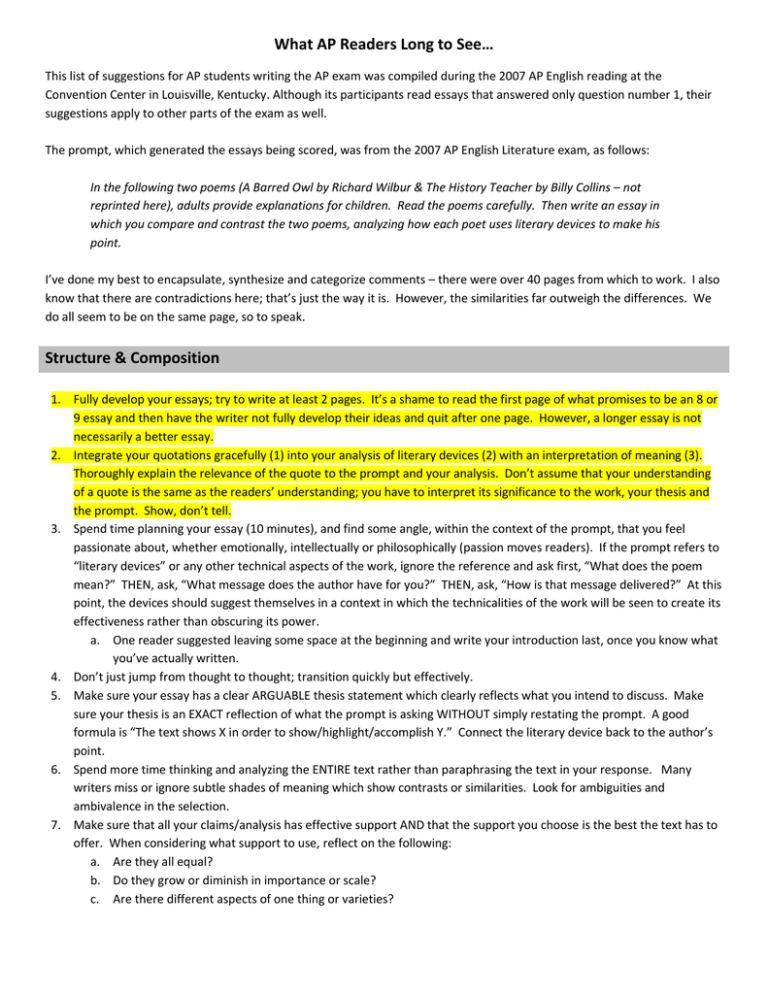
What AP Readers Long to See… This list of suggestions for AP students writing the AP exam was compiled during the 2007 AP English reading at the Convention Center in Louisville, Kentucky. Although its participants read essays that answered only question number 1, their suggestions apply to other parts of the exam as well. The prompt, which generated the essays being scored, was from the 2007 AP English Literature exam, as follows: In the following two poems (A Barred Owl by Richard Wilbur & The History Teacher by Billy Collins – not reprinted here), adults provide explanations for children. Read the poems carefully. Then write an essay in which you compare and contrast the two poems, analyzing how each poet uses literary devices to make his point. I’ve done my best to encapsulate, synthesize and categorize comments – there were over 40 pages from which to work. I also know that there are contradictions here; that’s just the way it is. However, the similarities far outweigh the differences. We do all seem to be on the same page, so to speak. Structure & Composition 1. Fully develop your essays; try to write at least 2 pages. It’s a shame to read the first page of what promises to be an 8 or 9 essay and then have the writer not fully develop their ideas and quit after one page. However, a longer essay is not necessarily a better essay. 2. Integrate your quotations gracefully (1) into your analysis of literary devices (2) with an interpretation of meaning (3). Thoroughly explain the relevance of the quote to the prompt and your analysis. Don’t assume that your understanding of a quote is the same as the readers’ understanding; you have to interpret its significance to the work, your thesis and the prompt. Show, don’t tell. 3. Spend time planning your essay (10 minutes), and find some angle, within the context of the prompt, that you feel passionate about, whether emotionally, intellectually or philosophically (passion moves readers). If the prompt refers to “literary devices” or any other technical aspects of the work, ignore the reference and ask first, “What does the poem mean?” THEN, ask, “What message does the author have for you?” THEN, ask, “How is that message delivered?” At this point, the devices should suggest themselves in a context in which the technicalities of the work will be seen to create its effectiveness rather than obscuring its power. a. One reader suggested leaving some space at the beginning and write your introduction last, once you know what you’ve actually written. 4. Don’t just jump from thought to thought; transition quickly but effectively. 5. Make sure your essay has a clear ARGUABLE thesis statement which clearly reflects what you intend to discuss. Make sure your thesis is an EXACT reflection of what the prompt is asking WITHOUT simply restating the prompt. A good formula is “The text shows X in order to show/highlight/accomplish Y.” Connect the literary device back to the author’s point. 6. Spend more time thinking and analyzing the ENTIRE text rather than paraphrasing the text in your response. Many writers miss or ignore subtle shades of meaning which show contrasts or similarities. Look for ambiguities and ambivalence in the selection. 7. Make sure that all your claims/analysis has effective support AND that the support you choose is the best the text has to offer. When considering what support to use, reflect on the following: a. Are they all equal? b. Do they grow or diminish in importance or scale? c. Are there different aspects of one thing or varieties? 8. The conclusion should be a separate paragraph, even if you only have time for one sentence. Don’t just stop after your last argument, and avoid simply repeating your introduction in your conclusion. A good conclusion could restate the thesis, emphasize salient aspects of the essay and end with a provocative clincher. 9. While avoiding the formula of the five-paragraph essay, it would also be helpful to see more than one or two GIGANTIC paragraphs. Because readers read through only once and quickly, not having those cues to where ideas begin and end contributes to the incoherency of an essay. Structure is part of essay writing, and students need to show that they can command the language and their thoughts into a structured essay. 10. Don’t use plot summary in your response. “Summary is death!” 11. Evidence, evidence, evidence! 12. Avoid formulaic writing, especially in the opening of your essay. If you use a formula to get the pen moving, then do, but if 10 or 15 seconds though will help you craft something more creative or original or efficient, that that’s 10 seconds well spent. Readers will read hundreds and hundreds of essays, 90% of which start the same way (think refrigerator word magnets simply rearranged a thousand different ways), and if you can create something memorable (but not wacky), it may bring more attention to your work. 13. Don’t use line numbers, but briefly quote instead. Line numbers never substitute for the actual quote when supporting a point, AND most readers will not go back to the poem or text to see which lines you are referring to. Finally, when quoting, don’t simply give the first and last words with an ellipsis in between. Use the exact words that are most important in demonstrating your point. 14. Take some time to consider point of view and audience before digging in. Many essays confuse the actual purpose of the text by not thinking about or ignoring the proposed audience or point of view. 15. Teachers should remind students that they can write on any work OF LITERARY MERIT which is a PLAY or a NOVEL. Some students wrote notes that they hadn't read any of the suggested works so they were giving up. In addition, the reading slowed down as readers searched the table for someone who might even recognize titles that none of us had heard of. Style 1. Avoid long, flowery (purple prose), showy, catchy, etc, introductions; stick to a few sentences and get to the point (aka your thesis). 2. Don’t moralize or comment on the quality of the work – “I liked the poem,” etc; focus on literary analysis as a means to convey your opinions not on how you personally felt about the selection. And, don’t comment on the author, either: “Such and such was a great 20th century author who….” Or “Milton does a great job of …” 3. Try not to be too controversial, politically speaking. 4. Avoid affective fallacy, which argues that the reader's response to a poem is the ultimate indication of its value. 5. Creative writing is not academic writing. 6. Take some risks. Be aware of your strengths as a writer and show them off. Be critical and analytical. 7. Develop your essay well, but be thinking about being concise, too. Less can be more. 8. Don’t repeat yourself. Find new ways to say the same thing if you must reiterate a point. 9. Write as legibly and neatly as possible; WRITE USING LARGE LETTERS. Readers will always do their best to read every word, but stumbling through an essay which is illegible, too small or too big does impact our understanding of the response. 10. It’s not necessary to write titles for your responses; in fact, many readers do not like them at all. 11. Don’t confuse the characters in a poem or text with the audience or the speaker of the piece. Don’t confuse the speaker with the author, either. 12. Avoid lists: “The writer uses words such as …to show…” 13. Complex ideas require complex or multiple sentences. Don’t oversimplify. 14. Do not use little hearts, stars or circles to dot your “i’s.” It makes your essay harder to read and takes away valuable time from your analysis. 15. Use a black pen. 16. Use an active voice, simple present tense (literary tense) and strong verbs. 17. Be yourself! Strut your stuff! Use your own voice in the essay. BUT, don’t show off or “act smart” either. Patronizing or pretentious essays often don’t make the cut because the author is more interested in himself or herself than in taking care of business (aka answering the prompt). 18. We don’t care about your love life, your opinions on Iraq or the US government, your ex-boyfriend or girlfriend, how you’re having a bad hair day, your unreasonable parents, or your lousy AP teacher (at least for the purposes set before us) – write about the literature. 19. Avoid “fluff.” 20. When editing your writing, try not to make changes within the sentence; simply cross out the whole sentence and start over. 21. Don’t apologize in your essay for a lack of understanding, learning, etc. Show what you can do; don’t apologize for what you can’t do. Focus – aka THE PROMPT 1. Respond to the prompt and the prompt ONLY (AP = Address the Prompt – accurately, completely and specifically). Make sure you have a clear understanding of what the prompt asks before beginning, and don’t twist it into what you really want to write about. We readers need to know what and how you understood the text and its relationship to the prompt. This came up many, many times and is probably the most important part of your task. Too many great essays go down in flames because the student simply did not respond to the prompt. 2. Be as specific as possible with your analysis as it refers to the prompt. Don’t over-generalize. Generalizations don’t make good evidence to support assertions. 3. Don’t simply restate the prompt in your introduction. Using language from the prompt is fine when and if it is combined with an interpretation which you plan on pursuing in the essay. 4. Some literary devices are genre specific; know the difference. There is some overlap, of course, but certain distinctions are worth noting. 5. Don’t simply list devices; focus on a few and show how AND WHY they are used – what the device adds to the meaning of the text. Literary devices are not important in and of themselves, and truly excellent writers don’t just observe devices, they discuss their consequences. Literary devices are tools the author uses to create meaning. Ask yourself “So what?” If there’s a rhyme scheme, so what? What purpose does it serve? 6. Especially when responding to poetry, explain how form relates to content. Form and content are mutually constitutive; any discussion of one should include the other. 7. Literary terms should be used correctly and appropriately. If you’re not sure what a term means or refers to, don’t use it in your essay, and don’t make up devices. Finally, don’t take time to define literary terms. We’re English teachers; we already know them. Instead, focus on explaining how the literary device is being used effectively. 8. When you analyze a work, assess the whole work from start to finish as an organic whole. Don’t carve your analysis into paragraphs for each device; evaluate how the work builds to its conclusion and creates its tone and effects. 9. Don’t forget what are often the most important parts of a text, especially a poem: THE TITLE AND THE ENDING. 10. When asked to compare and contrast, remember that simply because one text uses devices X, Y and Z does not mean that the second text uses the same devices and, therefore, must be part of your analysis. You should be looking at overall meaning and how the author achieves that meaning regardless of the devices involved for each text. 11. Don’t write about ANYTHING which can’t be related back to the theme and the prompt. Also, don’t show off by alluding to other works that you have read or studied, not even in the conclusion. Doing so almost always diminishes your other observations. 12. Take some time to review your essay and make sure it relates back to the prompt. Many essays start our well focused and end up digressing. 13. Many readers responded that you should try to discuss rhyme, structure, etc when working with poetry BUT ONLY if you know what you are talking about. The same is true when dealing with structural attributes of prose passages. BUT, don’t ONLY discuss structure, and don’t assume that structure is the end all or be all of the analysis. 14. If you don’t have much to discuss, do it quickly. 15. If you think a selection is too simple or easy, look again! 16. Don’t force symbolism into your analysis. Everything is not symbolic. It is better to miss symbolism that only might exist than to distort the meaning of the work by creating symbols that are simply not there. Vocabulary & Word Choice 1. The term “diction” does not mean “word choice.” It refers more specifically to the formality of the writer’s language. Looking closely at the writer’s selection of words and phrases, along with his or her use of sentence construction and syntax, all lead to determining the diction of a selection. 2. When comparing and contrasting, don’t write that the texts are similar and different or that they are “the same and different.” This comment was made MANY times. 3. Avoid the use of clichés. 4. Put your time into answering the prompt – understatement is fine instead of litotes, for example. 5. Do not inflate your essay with jargon. Readers know “big words,” too. They may know more of them than you. Instead, use words effectively and in context. Simple, clear, and direct diction is preferable to high-toned literary bafflegab (pretentious and obscure talk full of technical terminology or circumlocutions). 6. Do not misspell the names of poets, authors, poems, books, terms from the prompt, etc. It looks sloppy. Plus, poems are not plays or novels; plays are not poems or novels; and novels are not poems or plays. 7. Know the differences – analyzing, explaining, paraphrasing, summarizing, describing, etc. 8. “Simplistic” doesn’t mean “simple.” 9. Mastery of grammar and mechanical skills is important and strengthens the essay. 10. Writers don’t “use” diction or tone, nor do they “use literary terms” in their writing. ALL sentences have diction and syntax. The questions is, therefore, what kind of diction and syntax is being used AND why. Don’t write that, “The author uses diction (or syntax or whatever) to show his or her meaning.” 11. A rhyme scheme and/or metrical pattern do not mean the poem is “sing songy” or “childlike.” 12. Avoid the word “flow”; it means nothing. 13. Poems and stories are not “journeys.” 14. Don’t talk about the effect something has on the reader’s feelings or emotions. In fact, avoid the word “feel” altogether. Example: “…to make the reader feel…”; “…a story-like feel versus a rhythmic feel...”; “As one reads, it will make the reader flow through the poem and feel like he is there.” 15. Authors don’t “use” devices to make something interesting, more accessible or more complicated to read or understand. 16. Avoid using the diminutive or augmentative forms of words simply to highlight what may be more subtle differences in meaning. 17. Don’t create “new” words (or neologisms) in your essays. 18. Avoid empty words: unique, different, similar, negative, etc – make your own “weak word list.” 19. “Rhyme” does not mean the poem is simple. 20. Poetry is written in stanzas not paragraphs. 21. Avoid “in today’s society” and “paints a picture.” 22. Words are not a poetic device. 23. Mood and tone are not the same thing. One teacher emailed me to put a plug in for his work AP Guide for Teachers (Jamieson Spencer and Dr. Kathleen Puhr), that goes in a set with Bob DiYanni's Literature text (McGraw Hill). There is a small chapter that includes further suggestions for students on writing AP essays.
